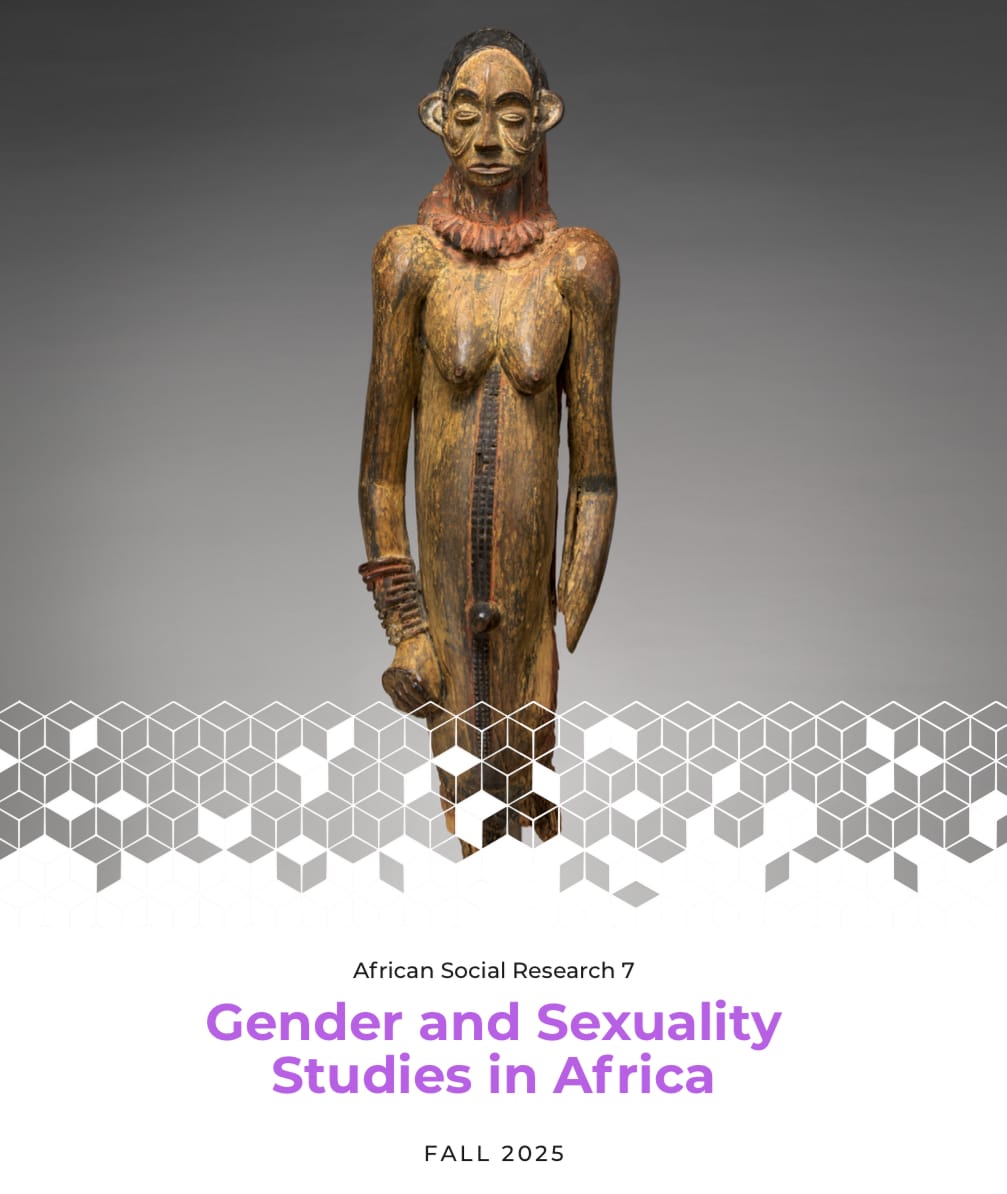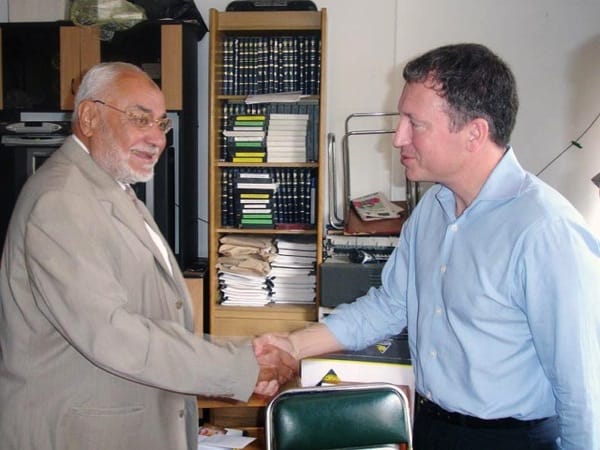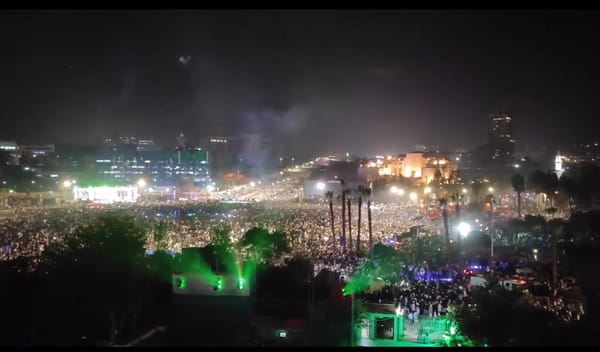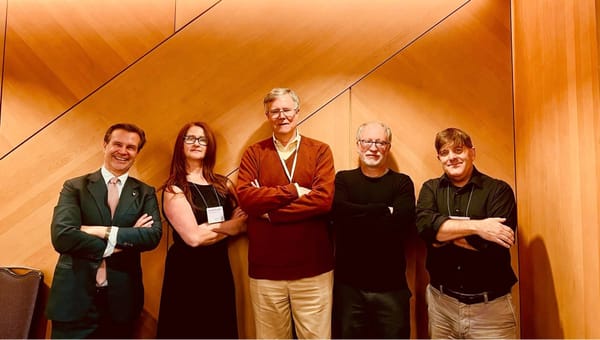What were the Abraham Accords?

Plus a full roundup from the MENA Academy and a new publication on gender and sexuality in Africa
It's time for our regular roundup of research and articles from the MENA Academy and it's a really rich crop! But first, I'm delighted to share the video of last week's conversation with Marie Harf at the University of Pennsylvania's Perry World House on my new book America's Middle East: The Ruination of a Region, which Oxford University Press has made available in the US more than a month early, I'm delighted to report - get the Kindle edition immediately, you know you want to know what everyone's talking about.
I also want to flag the publication of African Social Research 7: Gender and Sexuality in Africa. This fantastic open access journal, which I edit, collects essays by emerging scholars, mostly from the African continent, based on workshops organized by the Program on African Social Research in collaboration with African institutions. This collection is based on a terrific workshop held in Nairobi with The Feminist Centre for Racial Justice and The African Leadership Centre, in partnership with the Kenyan feminist intellectual and founder of FCRJ, Awino Okech, Professor at the School for Oriental and African Studies, with fifteen participants from across Africa.
As Zachariah Mampilly frames the collection in his introduction, "African feminists and queer intellectuals from across the continent have long pioneered grounded and dynamic understandings that pay attention to the nuanced ways that gender and sexuality interact and influence the broader society, culture and politics. Those diverse traditions of African thought regarding gender and sexuality share a commitment to theorizing from an African standpoint and a desire that the work move beyond the page to inform political movements and debates." Contributions range across disciplines, methodologies, and orientations. I learend a tremendous amount from working with these brilliant young scholars, and I'm excited to share the free PDF of the new issue.
Closer to our regular focus on the Middle East, I was excited to see the publication of MERIP's Middle East Report 315/316: "The Material Politics of Normalization." Here's the official abstract: "The issue reassesses the US-brokered Abraham Accords of 2020, which forged political, economic and security ties between Israel and four Arab states: the UAE, Bahrain, Morocco and Sudan. This issue comes together at a pivotal moment: amid the Global Sumud Flotilla’s worldwide campaign to break the siege of Gaza, the recognition of Palestinian statehood by a growing number of Western states—including Spain and Britain—and a tentative ceasefire between Israel and Hamas brokered by the Trump administration on October 9, 2025. It situates the Accords in this present, tracing how earlier models of normalization—with Egypt in 1979 and Jordan in 1994—have evolved into today’s multilayered partnerships. Far from establishing a diplomatic breakthrough on Palestine, the Accords unveiled a grimmer reality, in which Arab states have poured capital into Israel’s military-industrial and technology sectors, binding regional economies to the political and economic infrastructure of Palestinian dispossession. Taken together, our contributors reveal the multiple modes by which normalization reinforces regional hierarchies and dependence on Israeli and US power, while crafting a new grammar of inclusion and exclusion, prosperity and dispossession as the bedrock of state violence and regional alliances."
Standout articles include Rafeef Ziadeh's "Hardwiring Normalization—Infrastructures, Extraction and Gaza’s Future", Tariq Dana's "The Military-Industrial Backbone of Normalization", Hicham Safieddine's "From Oslo to Offshore—The Rise of Energy Normalization in the Eastern Mediterranean", Majd Bargash's "Energy, Water and the Cost of Jordan’s Dependence on Israel", Bayan Abubakr's "The Abraham Accords and Sudan’s Global Counterrevolution", and Arang Keshavarzian's review of Elham Fakhro's excellent Columbia University Press book The Abraham Accords.
There's been some great work on the Middle East published across the academic journals over the last two weeks. We start by featuring two articles on Syria's 2011 uprising: one by Konstanin Ash and Kevin Mazur on ethnic targeting of protests, and other by Manal Al-Natour on Syrian women activists. We then present a fascinating theoretical discussion of Yemen's state during civil war by Moosa Elayah. Next up, two articles on the long-running theoretical debate about Islamist movement moderation and inclusion, one by Zoltan Pall on Kuwait and the other by Lalla Amina Driheur comparing Turkey and Morocco. Margot Dazey has a really fascinating article on French Muslim professionals and transnational racial politics. Katharina Grüneisl has a contribution to a special issue which theorizes the underexplored political implications of Jordan's special economic zones. Finally, we have several articles on youth movements, one by Zoheir Gabsi on Tunisian online youth mobilization and the other by Enea Fiore on Lebanon's October 2019 uprisings.
Konstanin Ash and Kevin Mazur, "Ethnicity and Strategic Repression of Protest during the 2011 Syrian Uprising," Perspectives on Politics (October 2025). ABSTRACT: Why do incumbent governments carry out harsher repression against some opposition groups than others? Drawing on research on the coalitional nature of revolutions, we contend that governments target repression at segments of the challenger group they perceive as most threatening in order to fragment the challenger coalition. We illustrate this argument by analyzing protest repression during the 2011 Syrian uprising. We find that protestors in majority-Kurdish towns in Syria’s northeast region were significantly less likely to face lethal repression than those in nearby Sunni Arab towns protesting at the same rate. Qualitative evidence from interviews and the Arabic-language secondary literature demonstrate that the Syrian regime shaped its strategy of repression around diverting Kurdish protests from the regime-focused demands of the revolution, thereby separating Kurds from the primarily Sunni Arab opposition. These findings have implications for how ethnic and other identities can be used by incumbents and how incumbent regimes communicate with their populations through the selective deployment of violence.
Manal Al-Natour, "Intellectual and Creative Paradigms: Syrian Women Resistance Approaches," Journal of Middle Eastern Women's Studies (October 2025). ABSTRACT: This study examines the role of young Syrian grassroots-level women organizers from inside and outside Syria in the Syrian Revolution of 2011, with particular emphasis on two approaches adopted by the voices of nonviolent activists: dialogical and dialectical. Based on interviews conducted with Syrian women, this essay analyzes the nonviolent movement in relation to intersectional paradigms of ethnicity, gender, and nation, focusing on the subjectivity of Syrian women and investigating their strategies of nonviolent resistance. It examines how Syrian women viewed the intersectionality of their lives and activism by raising awareness of gender aspects in the Syrian revolution. The article claims that Syrian activists view the dichotomy of the oppressed and oppressor in a complex manner, carving out new spaces and roles for themselves within the structure of the revolution and its narrative. It further contends that examining the myriad ways in which these women experience political oppression enhances the understanding of the composition of Syrian women’s resistance and the politics of their belonging to Syria. Investigating the collective narrative of Syrian women’s nonviolent resistance, this essay highlights women’s agency in creating change and advancing a democratic and pluralistic Syria.
Moosa Elayah, "The Empty State: Governing the Voids in a Projected
Conflict-Torn Yemen," Politics and Policy (October 2025). ABSTRACT: This study introduces the concept of the “Empty State” to explain a form of state dysfunction in Yemen, where state institutions exist but are stripped of their governance authority. While frameworks on fragile or failed states emphasize the weakness or
collapse of state capacity, the Empty State highlights the persistence of symbolic institutions that project authority but are run by informal networks, ideology, and external actors. Unlike the “institutional void” or “shadow state” models, the Empty State captures the coexistence of institutional form and functional absence. Institutions are hollow and strategically preserved to simulate legitimacy and sovereignty. This framework is grounded in a qualitative study of 40 interviews with government, civil society, and tribal leaders. Findings reveal two governance patterns: centralized yet ideologically hollow rule in the North, and fragmented, externally influenced administration in the South. These patterns exemplify the Empty State and challenge linear models of fragility and collapse.
Zoltan Pall, "Legislating Islam: Islamists’ and Salafis’ Distinct paths of moderation in the Kuwaiti parliament," Democratization (October 2025). ABSTRACT: This article examines how ideologically distinct Islamic actors – namely, the Muslim Brotherhood–affiliated Islamic Constitutional Movement (HADAS) and Kuwait’s Salafi blocs – respond to institutional inclusion within a semi-democratic regime. Kuwait’s National Assembly offers a context where both movements have participated in formal politics under identical parliamentary conditions. Drawing on parliamentary debates, legislative records, public statements, and field interviews conducted between 2010 and 2025, the article levelled how these actors engaged two contentious policy issues: female suffrage and the rights of stateless residents. While both HADAS and Salafi MPs formally participate in the legislature, their modes of engagement diverge. HADAS has demonstrated greater ideological flexibility and political pragmatism. In contrast, Salafi MPs largely retained doctrinal rigidity, especially on identity and moral issues. The article refines the inclusion–moderation thesis by showing that participation does not generate uniform outcomes: ideological tradition, internal structure, and strategic horizons shape how moderation is performed. The findings challenge monolithic readings of “Islamist moderation” and underscore the need to disaggregate Islamist actors when analysing their behaviour in hybrid regimes. This case contributes to broader debates on institutional co-optation, ideological adaptation, and the conditional pathways of political moderation.
Lalla Amina Driheur, "Rethinking the inclusion-moderation hypothesis through gender politics: A comparison between the AKP in Turkey and the PJD in Morocco", Journal of North African Studies (October 2025). ABSTRACT: In 2003, the Turkish AKP ratified the International Covenant on Civil and Political Rights, recognising legal equality between men and women. Similarly, in 2004, the Moroccan PJD endorsed the reform of the Family Code (al-mudawwana), setting men and women on equal footing in regard to the family. Why do Islamic-oriented political parties make ideological concessions and adopt gender reforms that run contrary to their conservative and family-centred perception of gender? The inclusion-moderation hypothesis expects religious parties to abandon their revolutionary project and adopt liberal democratic values once they decide to participate in formal politics. Accordingly, the AKP and the PJD have adjusted to the pressure of their respective socio-political contexts by accommodating certain women’s demands. However, this accommodation does not mean that either party has renounced its religious conservatism. Both have established women’s branches and formed alliances with women’s organisations aligned with their ideological orientations. This strategic cooperation has allowed them to reproduce and reinforce their conservative identities while appealing to women. In this sense, women have become active agents for societal mobilisation and political outreach. Political Islam is becoming feminised – – it is acquiring a female face.
Margot Dazey, "Status (in)congruence in migration: Transnational mobilities and class aspirations of French Muslim professionals," French Politics (October 2025). ABSTRACT: The social order is sustained by interlocked racial-class hierarchies. Building on a case study of transnationally mobile French Muslim professionals, this article examines the national entrenchment of these racial-class hierarchies. It unpacks the various racial-class formations migrants encounter during their transnational journey, and how these formations manifest as embodied dispositions. For many French Muslim professionals, spatial mobility serves a project of racial and class mobility, providing access to middle-class privileges previously denied to them in France. It also renders more tangible the national foundations of racism and Islamophobia, making strange taken-for-granted situations in French society. Drawing on extensive interviews that center on life histories, the article emphasizes how minority individuals acquire knowledge about racism and make sense of these experiences as they move across borders. Ultimately, it argues that spatial mobility can have transformative effects on the incorporated sets of racialized dispositions that propel individuals to see, feel, and act in certain ways, pointing to the heuristic value of a transnational approach to intersectionality studies.
Katharina Grüneisl, "Governing through extra-territoriality: Jordan's clothing production zones as tools of imperial power and authoritarian rule," Political Geography (October 2025). ABSTRACT: Jordan's Export Processing Zones (EPZs) for clothing production form part of political geographies of US imperialism in the Middle East, and have served to bolster Arab-Israeli normalisation and authoritarian governance. A close-up study of these extra-territorial production spaces reveals how ‘free trade’ and associated neoliberal development agendas served to lastingly reconfigure political geographies in Jordan. Preferential US trade policies – granted to Jordan in exchange for signing peace with Israel in 1994 – translated into the creation of extra-territorial production zones (EPZs) and transformed Jordan into an attractive manufacturing location for the footloose global garment industry. Fiscal and regulatory exemptions facilitated the exploitation of labour and land reserves, benefitting a narrow local elite and thus generating new business-state alliances in favour of normalisation agendas. When Transnational Corporations (TNCs) for clothing production replaced most Jordanian-Israeli joint ventures in the EPZs in reaction to the 2001 full Free Trade Agreement with the US, foreign corporate actors began to assume a prominent role in Jordan's state performances. The co-production of positive macro-economic indicators that keep Jordan eligible for loans; as well as the redistribution of extra-territorial privilege to regions where the regime's political legitimacy is contested; expose shared mechanisms of governing through extra-territoriality. Taken together, this close-up empirical exploration of the extra-territorial clothing production regime challenges the façade of economic stability that Jordan's integration into global markets generated. Instead, it foregrounds how US free trade policies widened the rift between official state politics and the lived realities of most Jordanians, producing grievances that can only be managed through authoritarian repression.
Zoheir Gabsi, "Digital mediascapes and cultural transformation: youth identity formation in Tunisia’s post-revolutionary digital sphere," Continuum (October 2025). ABSTRACT: This article examines the intersection of digital media spaces and cultural transformation in post-Arab Spring Tunisia, exploring how emerging mediascapes shape youth political participation and identity formation. Through Foucault’s ‘heterotopia’ and Bourdieu’s youth as a ‘social construct’, this study investigates how young Tunisians use the physical and digital mediascapes to create their political and social identities. As they move from conventional physical locations to digital platforms, the research reveals a profound cultural shift that gives rise to new forms of mediated citizenship. The global and local influences pull Tunisian youth in different directions, adding more complexity to their attitudes and behaviours. The study demonstrates how digital media spaces function as sites for political expression and cultural production while reconfiguring traditional civic engagement. Tunisian youth use digital platforms for everyday activities but avoid them for serious political involvement. Their acquired ‘glocal’ culture emanates from both the ‘global’ and the ‘local’, which creates spaces where the physical, digital, or mental overlap. The findings contribute to debates about digital media’s role in shaping public discourse and cultural identity. By examining the interplay between online and offline political participation, this research advances our understanding of how digital mediascapes influence cultural formations in contemporary societies.
Enea Fiore, "Party in the Arab Street: Dynamics of Partisan Engagement in Lebanon's October 17 Revolution," Mobilization (October 2025). ABSTRACT: Dual engagement, the phenomenon in which party loyalists participate in antisystem protests, emerged as a defining feature of Lebanon's 2019–2021 period of civil unrest. This crosspartisan participation revealed the strategic role that opposition parties play in shaping mass mobilization efforts. To explain this phenomenon, this study investigates both the political conditions and individual-level factors that enabled such seemingly contradictory participation. Using Arab Barometer data, various political participation theories are tested to identify the key predictors of dual engagement. The findings demonstrate that partisan factors are more significant predictors than traditional protest motivations, suggesting that partisans engage in antisystem mobilizations strategically to advance their parties' interests. As a result, opposition parties emerge as the primary drivers of their supporters' protest participation. This dynamic underscores how partisan commitment can strategically redirect protests from an antisystem orientation to an antigovernment focus. These findings have important implications for understanding political behavior in antisystem mobilizations and illuminate the complex interplay between political parties and social movements throughout the Middle East and North Africa.



